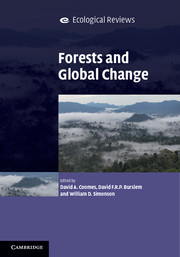Book contents
- Frontmatter
- Contents
- List of Contributors
- Preface
- Chapter One Forests and global change: an overview
- Part I Forest dynamics and global change
- Part II Species traits and responses to changing resource availability
- Part III Detecting and modelling global change
- Chapter Twelve A chemical-evolutionary basis for remote sensing of tropical forest diversity
- Chapter Thirteen Forests in a greenhouse atmosphere: predicting the unpredictable?
- Chapter Fourteen Detecting and projecting changes in forest biomass from plot data
- Chapter Fifteen Analysis of anthropogenic impacts on forest biodiversity as a contribution to empirical theory
- Index
- Plate Section
- References
Chapter Thirteen - Forests in a greenhouse atmosphere: predicting the unpredictable?
Published online by Cambridge University Press: 05 June 2014
- Frontmatter
- Contents
- List of Contributors
- Preface
- Chapter One Forests and global change: an overview
- Part I Forest dynamics and global change
- Part II Species traits and responses to changing resource availability
- Part III Detecting and modelling global change
- Chapter Twelve A chemical-evolutionary basis for remote sensing of tropical forest diversity
- Chapter Thirteen Forests in a greenhouse atmosphere: predicting the unpredictable?
- Chapter Fourteen Detecting and projecting changes in forest biomass from plot data
- Chapter Fifteen Analysis of anthropogenic impacts on forest biodiversity as a contribution to empirical theory
- Index
- Plate Section
- References
Summary
Introduction
Forest ecosystems are of key importance from the global to the local level, as they provide a multitude of goods and services upon which humanity depends (MEA 2005). Globally, forests are an important element of many biogeochemical cycles, among others the carbon cycle, with direct implications for atmospheric greenhouse gas concentrations as well as for the energy balance at the land surface (e.g. albedo); also, they harbour a considerable amount of terrestrial biodiversity. In many countries worldwide, forests continue to be an important element in the resource base of human livelihoods, including wood for construction and energy use, food and fibre, and many other products. Both regionally and locally, forests are important for mitigating soil erosion or protecting mountain settlements from rockfall and snow avalanches (IUCN 2008).
Humanity is facing the task of reducing carbon emissions from the burning of fossil fuels by c. 80% over the coming decades (IPCC 2007). Therefore, the role of forests will most likely increase in the future as an energy base as well as for the sustainable production of fibre; it has long been known that any petrochemically based good could be produced from wood compounds (Goldstein 1975). For all these reasons, understanding the factors and processes that shape the structure, composition and functioning of forest ecosystems is not only of scientific interest, but also of great practical importance in the context of the management of these systems in the face of multiple, often conflicting demands by human societies. Indeed, the dynamics of forest ecosystems at decadal to centennial time scales (subsequently referred to as ‘long-term forest dynamics’) have long fascinated and puzzled laypeople as well as scientists.
- Type
- Chapter
- Information
- Forests and Global Change , pp. 359 - 380Publisher: Cambridge University PressPrint publication year: 2014
References
- 7
- Cited by

